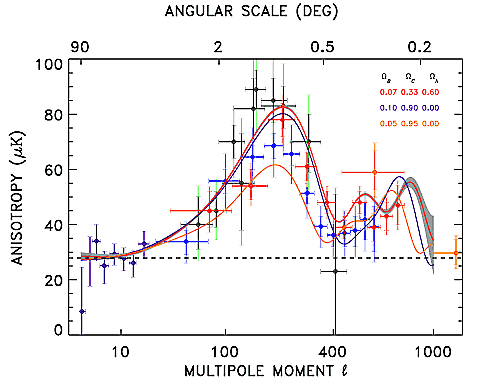
WMAP Sensitivity
The WMAP specification calls for an equal noise sensitivity per frequency band of ~35 µK per 0.3° x 0.3° square pixel. The mission duration required to meet this specification is two years of continuous observation. If Galactic emission is negligible at high latitudes above 40 GHz, as was the case for COBE, the sensitivity achievable by combining the three highest frequency channels is ~20 µK per 0.3° x 0.3° pixel. The following table gives the specified sensitivity for each of the five WMAP frequency bands.
| Frequency | 22 GHz | 30 GHz | 40 GHz | 60 GHz | 90 GHz |
|---|---|---|---|---|---|
| Specification | ~35 | ~35 | ~35 | ~35 | ~35 |
The corresponding sensitivity to the angular power spectrum is illustrated in the following plot which shows the anisotropy signal amplitude as a function of angular scale, which is characterized either by the “multipole moment” or by the angular scale in degrees. Three popular cosmological model curves are shown: the orange curve is the “Standard Cold Dark Matter (CDM)” cosmological model, the purple curve is a high baryon density CDM model, and the red curve is a cosmological constant model. The purple data points on the left are from COBE, the green data are from TOCO, the blue data are from BOOMERanG, the red data are from MAXIMA and the orange data are from CBI. The outer and inner error bars on the data represent the uncertainties with and without calibration uncertainties included, respectively. The gray band superposed on the “lambda CDM” model shows the expected WMAP 1-sigma error band. This band corresponds to two years of observations based on currently measured instrument performance, with a band width of delta l = 50, and a 10° Galaxy contamination cut.

